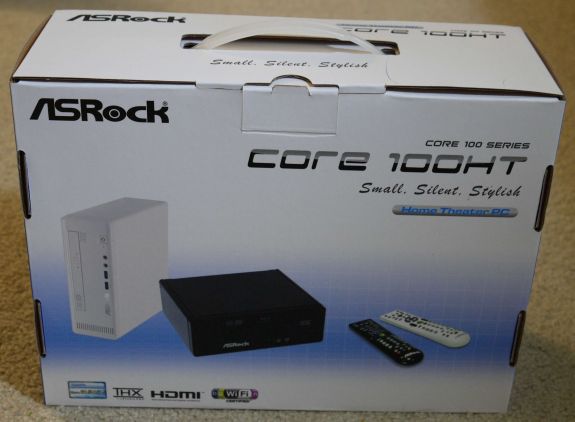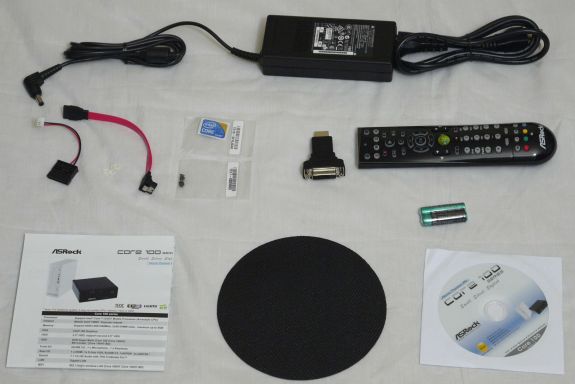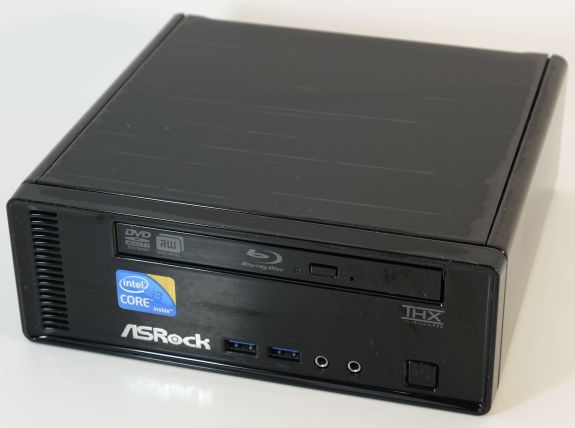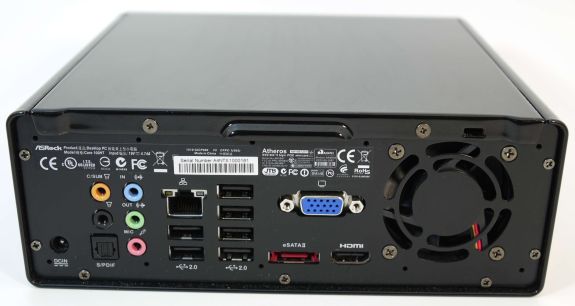ASRock Core 100HT-BD : Bringing HTPCs to the Mainstream Market [UPDATED : Noise Issue]
by Ganesh T S on July 19, 2010 9:34 PM EST- Posted in
- Home Theater
- Arrandale
- ASRock
- Media Streamer
- Core i3
- HTPC
The Core 100 HT-BD comes in a small package, and at first you wonder how such a powerful unit could come in such a small size.
Apart from the main unit, the package also bundles the following:
1. 90W AC / DC Adapter
2. SATA and power cables, as well as mounting screws for an optional second 2.5" hard disk
3. HDMI to DVI adapter
4. MCE remote and batteries.
5. Manual with instructions for disassembling and mounting the optional disk drive
6. Anti-slip pad for the base of the unit
7. CD with drivers and ASRock utilities
The appearance and dimensions of the unit are very similar to that of the ION 330-HT that was reviewed last August. The build quality of the chassis is top notch, and the unit will have no problem in blending with the A/V equipment of most consumers. However, the abrupt edges of the unit will not sit well with those interested more in the aesthetics and appearance rather than the internal capabilities of the unit. In the next iteration of the product, ASRock will probably work on the industrial design a bit more. Replacing the slimline Blu-Ray drive with a slot-loading type drive would also improve the appearance. These types of changes would enable them to cater to the segment of consumers who go more by the looks also.
We had mentioned in the ION 330 review about the absence of ports on the front panel being a bit strange, and ASRock has duly taken note, putting two USB 3.0 ports on the front panel. In addition, we also have headphone and microphone jacks in front. A set of vents on the left of the front panel helps in cooling the unit by maintaining air circulation. The slimline Blu-Ray drive is the same as those which make an appearance in various notebooks. The cost of such drives has come down drastically in the last 1 year, and we don't expect this component to add on too much cost over the DVD drive only version. Notably absent in the ION 330, but making an appearance in this unit is the THX logo above the power button to the right of the front panel.
ASRock uses the two sides of the unit as antennae for the Atheros WiFi module. Moving on to the rear of the unit, we find the adapter power input, followed by the audio ports. Analog audio output can be connected directly to the speakers, or the optical SPDIF output can be used to connect to older A/V receivers. Following this is the Gigabit Ethernet port, and 6 USB 2.0 slots. Further to the right, we have the VGA output (we really needed a DVI here), beneath which one gets the eSATA slot and HDMI output port. Wrapping up this panel is the ventilation fan. Our only gripe with the back panel is the placement of the eSATA port, which makes it difficult to connect external hard disks, particularly when the VGA port is being used.
Just like a notebook, this unit also supports simultaneous display on two monitors. Testing was done mostly with the HDMI output connected to a Toshiba REGZA 37" 1080p TV through an Onkyo TX-SR 606, and the VGA port connected to a old Dell monitor running at 1280x1024. It must be noted that the HDMI port on the unit is only 1.3a. This makes it impossible for the unit to drive monitors with resolutions higher than 1920x1080. Even extremely affordable 2048x1152 monitors such as this one from Dell are left unsupported at their maximum resolutions. However, we expect that this will not be a concern to buyers, since the unit will probably end up getting connected to a 1080p TV in most scenarios.
The Core 100 HT-BD ships with no OS installed. For the purpose of this review, we loaded up a copy of Windows 7 Ultimate x64. It is also possible to install Ubuntu or any other Linux distribution and still be able to take advantage of most of the HTPC functions of the system. Our analysis in the rest of the article, however, is completely from the Windows 7 standpoint.
Starting with this piece, all our media streamer and HTPC reviews will carry a table summarizing the data and A/V connectivity options for the unit from a home theater perspective. We will conclude this section with the same.
| Option | Status |
|---|---|
| HDMI | Yes [v1.3a] |
| Component | No |
| Composite | No |
| VGA | Yes |
| SPDIF | Yes [Optical] |
| Stereo | Yes |
| Option | Status |
|---|---|
| Optical Disk Drive | Yes [Blu-Ray] |
| USB | Yes [6 x v2.0, 2 x v3.0] |
| eSATA | Yes |
| LAN | Yes [ 1000 Mbps GbE ] |
| Internal HDD | Yes [ 500 GB ] |
| WiFi | Yes [ 300 Mbps 802.11n ] |
| Card Reader | No |














107 Comments
View All Comments
ganeshts - Tuesday, July 20, 2010 - link
Shadowmaster625,This unit is slightly on the leading edge (The Arrandales were introduced around 6 months back).
With $100, it is difficult to get a notebook with HD audio bitstreaming and Blu-Ray drive, even second hand.
For the set of features it offers, we think it is a decent value for money. As for this being mainstream, I am sure there are many who spend $700 or so on a PC once every 4 - 5 years, and this is a perfect system for such people.
tmservo - Tuesday, July 20, 2010 - link
Pray tell.. if you've got a way to get a case/motherboard/ram/hdd/bluray drive and get 1080P for under $100, I'm interested. Somehow, I don't see that as at all feasible. Hell, even the cheapest AMD CPU + board and a cheap case alone is $100. So, however you shoe horn in all those other components, or then get the software to run them (supplied here) ..But, if you'd like.. give me a part list of what you can get that anyone could go buy, NEW, for $100.
Or, find me a used laptop on Ebay with HDMI output that does 1080P and has a bluray drive for $100. Even if it has no screen. Needs to have a HDD, Memory, BD drive though.. and function.
cjs150 - Tuesday, July 20, 2010 - link
53 db!! That is just plain daft.I suspect the design of the case does not help.
I have just built a mini-server using a Atom 510 and I am sure the M/B was ASrock, mini-itx format and a PCI-E slot. Easiest build I have done even though the case was not perfect. As a server it is effectively silent
I do not want an HTPC that creates any more noise other than maybe a slow running 140mm+ fan
ganeshts - Tuesday, July 20, 2010 - link
cjs150,Note that the 53dB is under full load, when all threads are pegged at 100%, and it is just inches away from the unit. The farther you are, the lesser it is, and at 8ft, it was barely discernible.
Under idle, the unit is advertised as having 25dB noise, measured in an anechoic chamber (Refer YouTube video from their marketing department).
I would say, for HTPC purposes, the noise from the unit is definitely within limits.
tech6 - Tuesday, July 20, 2010 - link
Nice work Ganesh - I look forward to further HTPC reviews to see how the AMD platforms compete.shamans33 - Tuesday, July 20, 2010 - link
Ganesh,I'm curious as to how the IR receiver is connected to the motherboard...USB and/or motherboard headers? Is it possible to do a force power off (if let's say the system is frozen) or to do a cold boot up?
Thanks for reviewing more SFF items.
ganeshts - Tuesday, July 20, 2010 - link
shamans33,I believe the IR receiver is connected to a dedicated NuvoTon chip on the motherboard.
The power off button on the remote puts the system in sleep mode when the unit is in operation. In my usage scenario, I had the AC adapter connected to the back of the unit, and the system was completely shutdown. The Power button on the remote was able to boot up the unit without issues (even with Instant Boot disabled).
johnspierce - Tuesday, July 20, 2010 - link
Hi Ganesh,Very nice review, extremely thorough, thank you!
I have a question about how the HDMI handshaking works with the ASRock.
I have built several HTPC's with both NVidia and ATI HDMI-out video cards and it seems they all have a problem when I have it plugged into my HDMI-switching Onkyo receiver.
When I switch from HTPC to DVR and don't change back for awhile, it always has a problem with the display coming "alive" on the switch back. Turning the monitor off and on re-establishes the handshake, but this is an annoying trait of the current crop of video cards. Does the ASRock have this problem?
Also, I wanted to "weigh in" on the lack of a TV tuner -- I really think this is quickly becoming a non-issue since I now use an OTA receiver for local HD and everything else gets streamed. TV Tuners will soon be an anachronism in my opinion.
Thanks,
John
ganeshts - Tuesday, July 20, 2010 - link
johnspierce,I have the same handshaking issue with my ATI based HTPC.
As far as I could see, I didn't have the handshaking issue with the ASRock setup, but the whole testing was done with 2 displays connected to it. I will do a 'standalone' test and get back to you on this.
Aikouka - Tuesday, July 20, 2010 - link
A very interesting product indeed, but I've got my own three cents to provide!1) The price. Ouch... when I first opened this review, I checked the Egg to see if they had them in. Of course as the review mentions, I ended up finding the DVD-equipped model for $650. Tack on another $130 for Windows 7 Professional (note, I use Pro since it enables remoting in, which I find indispensible for a HTPC) and you've got nearly $800. If the Blu-Ray-equipped model retails for $700, you get $830 with the OS and then you have to consider that the blu-ray playback software will set you back another $100 (unless you can find them on sale... TMT3 has been on sale for $75 before).
I've spec'd out a few HTPCs in my quest to find the Holy Grail of HTPC devices, and if price were my main concern, I'd still probably go with my own build. I never put my HTPCs to sleep, so I'm honestly not even worried about that aspect and I don't mind a slightly higher power consumption.
2) The VIA VT2020. Have you noticed a strange amount of memory use from having this? I have an ASUS P7P55D-E Premium motherboard, which also features the same VIA audio chip, and I have god awful levels of memory use from audiodg.exe (Window 7's audio "controller"). At one point before upgrading my BIOS, I would literally see 800MB of memory being used by it. Last night I checked and I had 130MB of memory being used and I only had a single mp3 open. The worst part is that the last time I checked, VIA does not provide audio drivers for that chip. On their website they said that it was manufactured specifically for ASUS and to check their website for drivers.
But who knows... the strange things I see are possibly just issues with the P7P55D-E Premium... it's a god awful motherboard that was released with buggy BIOS revisions and it's no wonder you can't even buy it from NewEgg anymore.
3) The Front. Why do people want to see things like USB ports, bright blue LEDs and 3.5mm ports on the front of entertainment center components? The worst offender of the "sleak front" has to be that ghastly Intel i3 Inside sticker. I'd rather the connections be hidden under some sort of flap or door if they absolutely have to be on the front.
4) The remote. As something to mention, when I was discussing HTPC stuff on the Anandtech forums, a user clued me in on a nice Gyration MPC-capable remote that you could buy off eBay (from Lenovo it looks like) for only $50 that provided some mouse support if you ever needed it. I have to say that I quite like it so far and it might be something to look into if you don't like IR remotes. The only negative aspect is the ugly and obtuse dongle.
5) The comparison. It'd be nice to see how this item really compares to it's cousin, the ATOM-based version. Given the blu-ray version is available for $500 on NewEgg, does it handle all the necessary playback? A $200 savings for slightly longer application loads might be somewhat advantageous. Right now, I literally just leave my HTPC turned on 24/7 with WMC loaded up, so other than any necessary start-ups/shut-downs, I may see very little difference with the ATOM version.